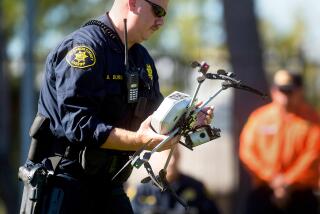Colorado, others vie with Oklahoma for drone test sites
- Share via
Oklahoma may be at the nexus of violent tornadoes and scientific developments in unmanned aircraft, but the state faces stiff competition in its bid to become one of the first six federal sites allowed to test the technology.
Fifty applications have been submitted from 37 states.
The University of Colorado at Boulder is among those vying for one of the spots. Boulder’s Research and Engineering Center for Unmanned Vehicles was the first institution to focus on small aircraft systems for atmospheric and meteorological research, said Brian Argrow, a professor in the department of aerospace engineering sciences who co-founded the center. The university announced its bid for one of the federal test sites in May.
Argrow said the University of Colorado first began flying unmanned aircraft--also known as drones--from Alaska in 1999, and has developed the technology ever since.
“We’re kind of a best-kept secret, to some degree,” he said.
Researchers hope the aircraft will deliver improved wind measurements, in addition to collecting data on pressure, temperature and humidity.
In 2009 and 2010, Argrow and his colleagues were part of a large-scale, federally funded pilot project that deployed unmanned aircraft to intercept thunderstorms for the first time. More than 100 scientists and engineers, as well as representatives from 16 universities, participated in the “Vortex 2” project, which involved roaming the Great Plains for about a month and a half with more than 40 specialized unmanned vehicles.
Teams gained Federal Aviation Administration certificates well in advance. In all, 59 certificates were granted, covering 24,000 square miles.
The project successfully showed storms could be sampled using unmanned aircraft, Argrow said. One of the six thunderstorms intercepted by the aircraft was generating tornadoes about 60 miles outside of Denver, and the aircraft managed to fly beneath it and collect measurements -- an example of what researchers hope to do more freely in the future.
While universities in different states are competing for spots as a federal test sites, the Vortex 2 project was an example of them coming together, Argrow said.
In another sign of joined forces, researchers at Oklahoma State University are developing a partnership that includes Oklahoma University, University of Colorado, University of Kentucky and Virginia Tech to vie for federal funding on future projects, said Jamey Jacob, a professor at OSU’s School of Mechanical and Aerospace Engineering, where unmanned aircraft technology is being developed.
ALSO:
Baby moose rescued from Montana river
Philadelphia equipment operator surrenders to police
Storm Andrea breaks rainfall records in the Northeast
devin.kelly@latimes.com
Twitter: @devkelly17
More to Read
Sign up for Essential California
The most important California stories and recommendations in your inbox every morning.
You may occasionally receive promotional content from the Los Angeles Times.













